Effective Performance Management Strategies at Morrisons Supermarket
VerifiedAdded on 2022/12/27
|11
|3620
|69
Report
AI Summary
This report delves into the performance management practices of Morrisons, a major UK supermarket chain. It begins with an introduction to performance management, highlighting its importance in optimizing workforce resources within a competitive business environment. The main body of the report examines various performance management models, including the Performance Management Sequence Model, and how Morrisons utilizes these models to enhance employee productivity and achieve organizational goals. It also explores key theories employed by managers to drive high levels of performance, such as Goal-setting Theory and Expectancy Theory, detailing their application within Morrisons' operational framework. Furthermore, the report discusses the types of performance management methodologies, tools, and techniques that are best suited to Morrisons' organizational environment. The report concludes with a summary of findings and references.
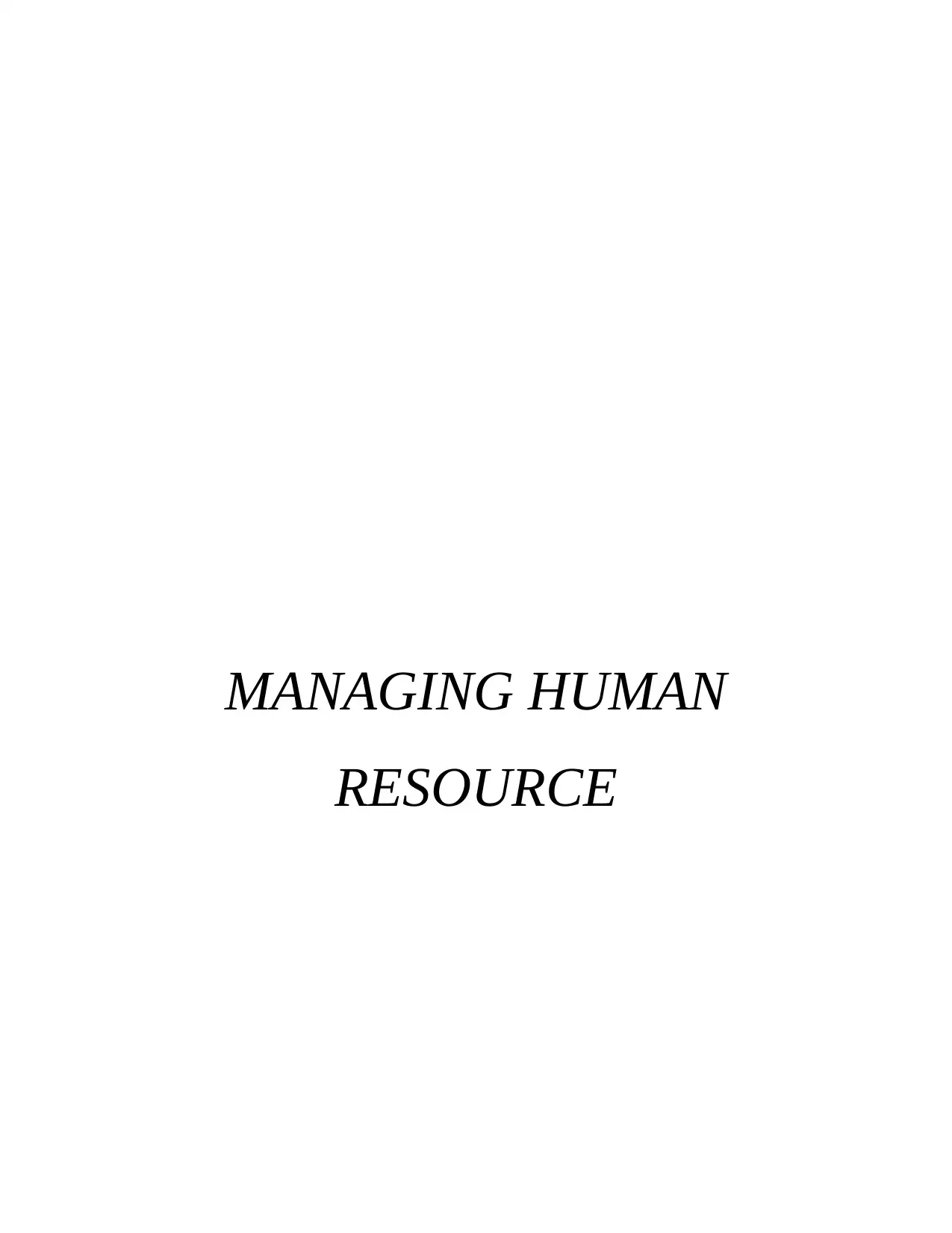
MANAGING HUMAN
RESOURCE
RESOURCE
Paraphrase This Document
Need a fresh take? Get an instant paraphrase of this document with our AI Paraphraser
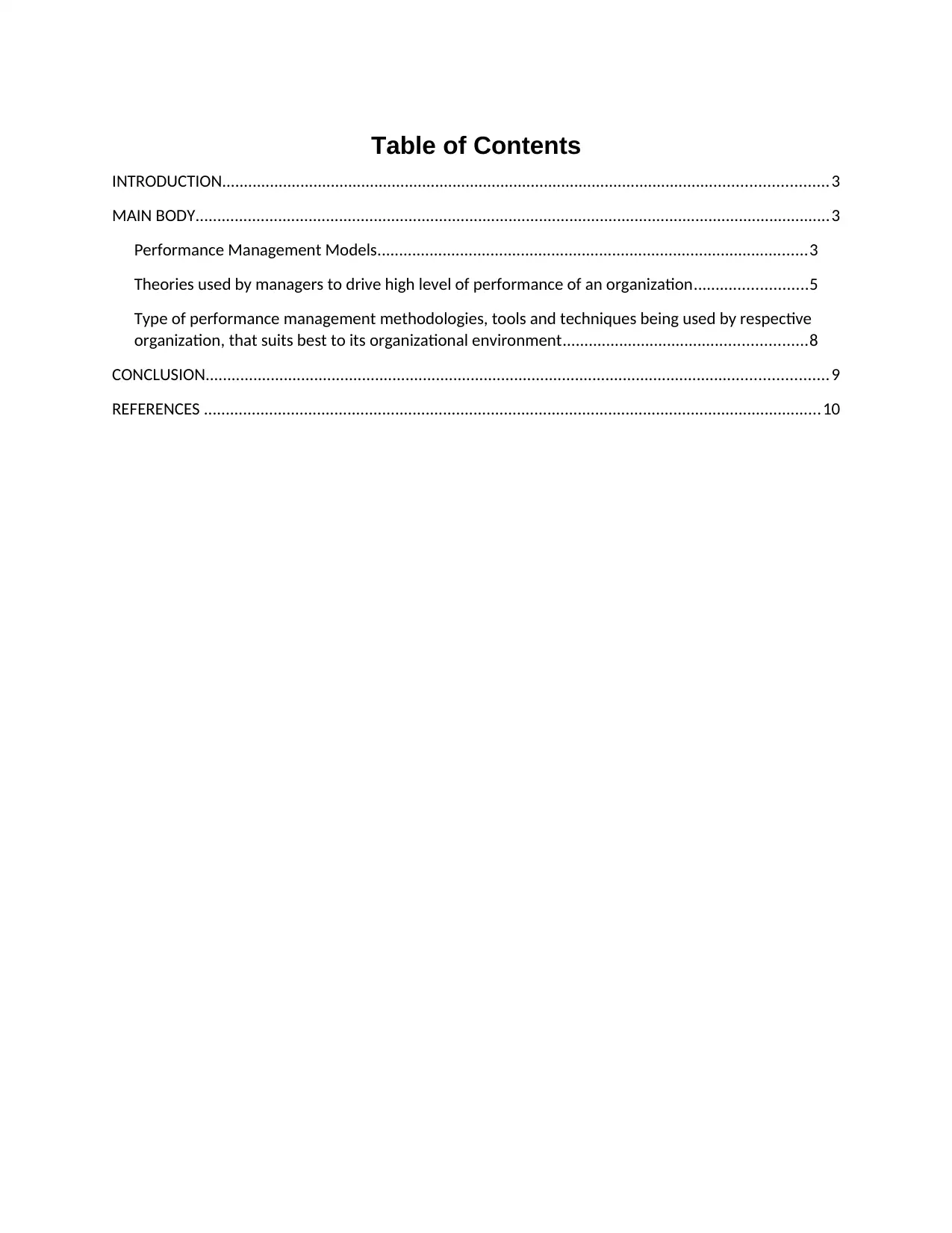
Table of Contents
INTRODUCTION...........................................................................................................................................3
MAIN BODY..................................................................................................................................................3
Performance Management Models...................................................................................................3
Theories used by managers to drive high level of performance of an organization..........................5
Type of performance management methodologies, tools and techniques being used by respective
organization, that suits best to its organizational environment........................................................8
CONCLUSION...............................................................................................................................................9
REFERENCES ..............................................................................................................................................10
INTRODUCTION...........................................................................................................................................3
MAIN BODY..................................................................................................................................................3
Performance Management Models...................................................................................................3
Theories used by managers to drive high level of performance of an organization..........................5
Type of performance management methodologies, tools and techniques being used by respective
organization, that suits best to its organizational environment........................................................8
CONCLUSION...............................................................................................................................................9
REFERENCES ..............................................................................................................................................10
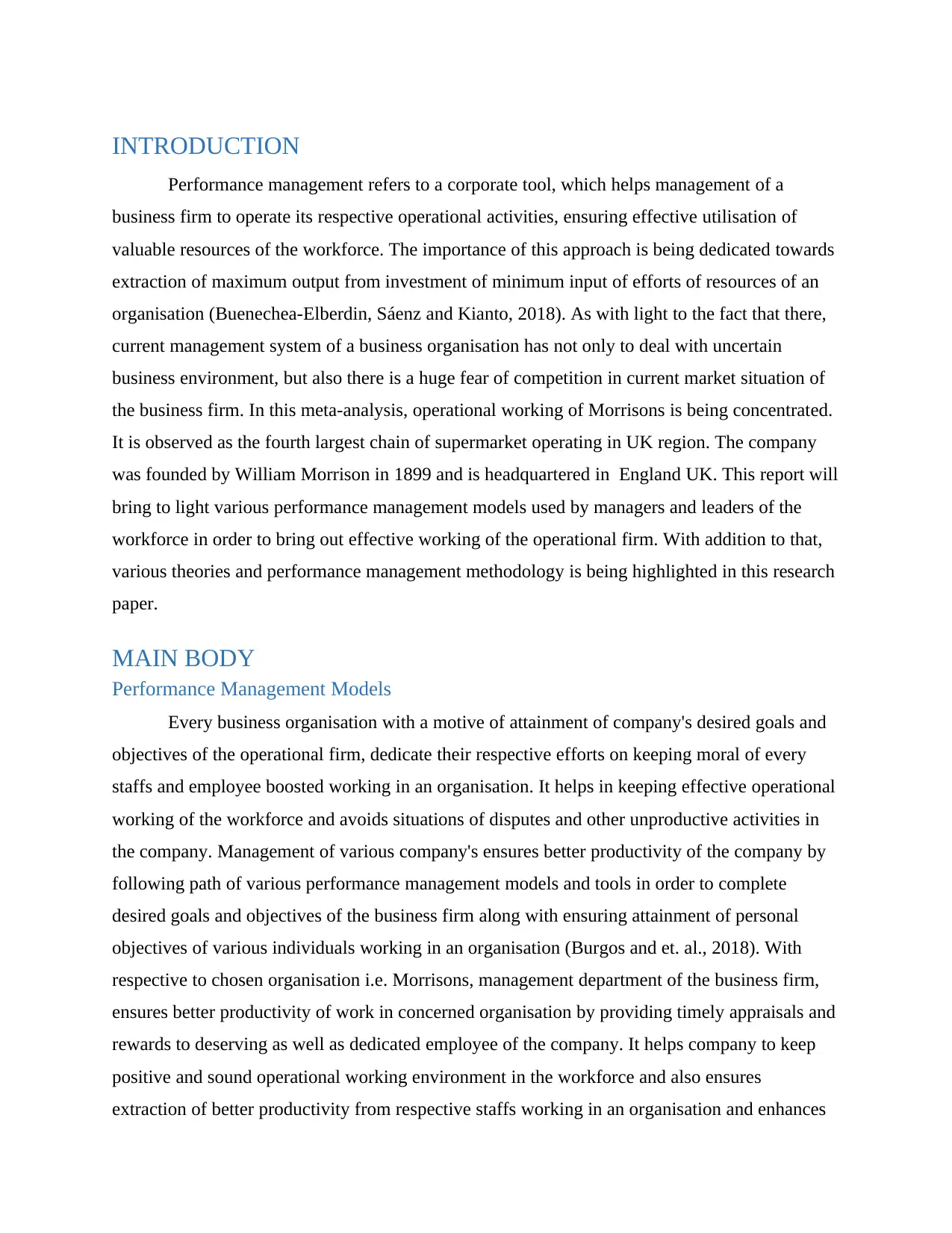
INTRODUCTION
Performance management refers to a corporate tool, which helps management of a
business firm to operate its respective operational activities, ensuring effective utilisation of
valuable resources of the workforce. The importance of this approach is being dedicated towards
extraction of maximum output from investment of minimum input of efforts of resources of an
organisation (Buenechea-Elberdin, Sáenz and Kianto, 2018). As with light to the fact that there,
current management system of a business organisation has not only to deal with uncertain
business environment, but also there is a huge fear of competition in current market situation of
the business firm. In this meta-analysis, operational working of Morrisons is being concentrated.
It is observed as the fourth largest chain of supermarket operating in UK region. The company
was founded by William Morrison in 1899 and is headquartered in England UK. This report will
bring to light various performance management models used by managers and leaders of the
workforce in order to bring out effective working of the operational firm. With addition to that,
various theories and performance management methodology is being highlighted in this research
paper.
MAIN BODY
Performance Management Models
Every business organisation with a motive of attainment of company's desired goals and
objectives of the operational firm, dedicate their respective efforts on keeping moral of every
staffs and employee boosted working in an organisation. It helps in keeping effective operational
working of the workforce and avoids situations of disputes and other unproductive activities in
the company. Management of various company's ensures better productivity of the company by
following path of various performance management models and tools in order to complete
desired goals and objectives of the business firm along with ensuring attainment of personal
objectives of various individuals working in an organisation (Burgos and et. al., 2018). With
respective to chosen organisation i.e. Morrisons, management department of the business firm,
ensures better productivity of work in concerned organisation by providing timely appraisals and
rewards to deserving as well as dedicated employee of the company. It helps company to keep
positive and sound operational working environment in the workforce and also ensures
extraction of better productivity from respective staffs working in an organisation and enhances
Performance management refers to a corporate tool, which helps management of a
business firm to operate its respective operational activities, ensuring effective utilisation of
valuable resources of the workforce. The importance of this approach is being dedicated towards
extraction of maximum output from investment of minimum input of efforts of resources of an
organisation (Buenechea-Elberdin, Sáenz and Kianto, 2018). As with light to the fact that there,
current management system of a business organisation has not only to deal with uncertain
business environment, but also there is a huge fear of competition in current market situation of
the business firm. In this meta-analysis, operational working of Morrisons is being concentrated.
It is observed as the fourth largest chain of supermarket operating in UK region. The company
was founded by William Morrison in 1899 and is headquartered in England UK. This report will
bring to light various performance management models used by managers and leaders of the
workforce in order to bring out effective working of the operational firm. With addition to that,
various theories and performance management methodology is being highlighted in this research
paper.
MAIN BODY
Performance Management Models
Every business organisation with a motive of attainment of company's desired goals and
objectives of the operational firm, dedicate their respective efforts on keeping moral of every
staffs and employee boosted working in an organisation. It helps in keeping effective operational
working of the workforce and avoids situations of disputes and other unproductive activities in
the company. Management of various company's ensures better productivity of the company by
following path of various performance management models and tools in order to complete
desired goals and objectives of the business firm along with ensuring attainment of personal
objectives of various individuals working in an organisation (Burgos and et. al., 2018). With
respective to chosen organisation i.e. Morrisons, management department of the business firm,
ensures better productivity of work in concerned organisation by providing timely appraisals and
rewards to deserving as well as dedicated employee of the company. It helps company to keep
positive and sound operational working environment in the workforce and also ensures
extraction of better productivity from respective staffs working in an organisation and enhances
⊘ This is a preview!⊘
Do you want full access?
Subscribe today to unlock all pages.

Trusted by 1+ million students worldwide
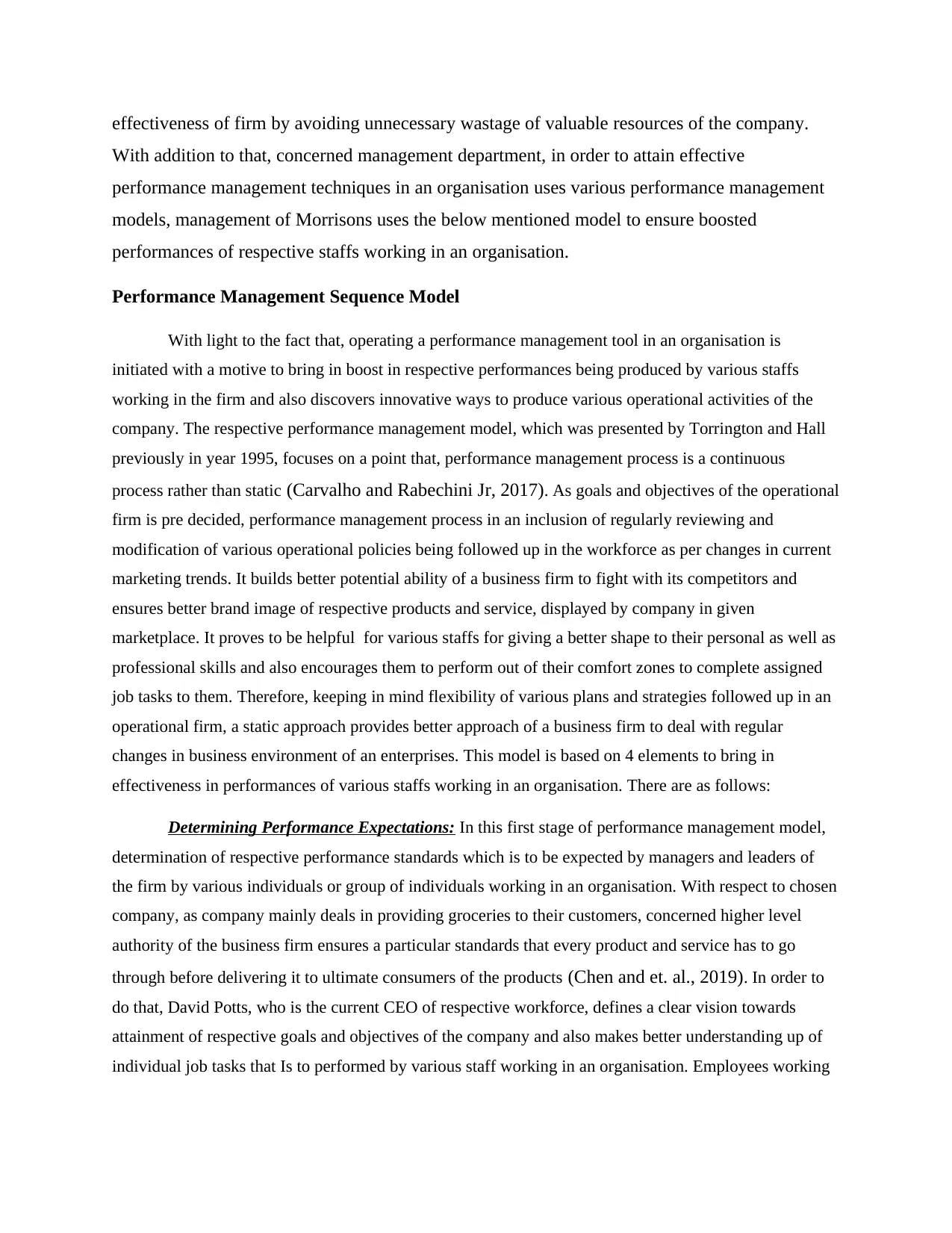
effectiveness of firm by avoiding unnecessary wastage of valuable resources of the company.
With addition to that, concerned management department, in order to attain effective
performance management techniques in an organisation uses various performance management
models, management of Morrisons uses the below mentioned model to ensure boosted
performances of respective staffs working in an organisation.
Performance Management Sequence Model
With light to the fact that, operating a performance management tool in an organisation is
initiated with a motive to bring in boost in respective performances being produced by various staffs
working in the firm and also discovers innovative ways to produce various operational activities of the
company. The respective performance management model, which was presented by Torrington and Hall
previously in year 1995, focuses on a point that, performance management process is a continuous
process rather than static (Carvalho and Rabechini Jr, 2017). As goals and objectives of the operational
firm is pre decided, performance management process in an inclusion of regularly reviewing and
modification of various operational policies being followed up in the workforce as per changes in current
marketing trends. It builds better potential ability of a business firm to fight with its competitors and
ensures better brand image of respective products and service, displayed by company in given
marketplace. It proves to be helpful for various staffs for giving a better shape to their personal as well as
professional skills and also encourages them to perform out of their comfort zones to complete assigned
job tasks to them. Therefore, keeping in mind flexibility of various plans and strategies followed up in an
operational firm, a static approach provides better approach of a business firm to deal with regular
changes in business environment of an enterprises. This model is based on 4 elements to bring in
effectiveness in performances of various staffs working in an organisation. There are as follows:
Determining Performance Expectations: In this first stage of performance management model,
determination of respective performance standards which is to be expected by managers and leaders of
the firm by various individuals or group of individuals working in an organisation. With respect to chosen
company, as company mainly deals in providing groceries to their customers, concerned higher level
authority of the business firm ensures a particular standards that every product and service has to go
through before delivering it to ultimate consumers of the products (Chen and et. al., 2019). In order to
do that, David Potts, who is the current CEO of respective workforce, defines a clear vision towards
attainment of respective goals and objectives of the company and also makes better understanding up of
individual job tasks that Is to performed by various staff working in an organisation. Employees working
With addition to that, concerned management department, in order to attain effective
performance management techniques in an organisation uses various performance management
models, management of Morrisons uses the below mentioned model to ensure boosted
performances of respective staffs working in an organisation.
Performance Management Sequence Model
With light to the fact that, operating a performance management tool in an organisation is
initiated with a motive to bring in boost in respective performances being produced by various staffs
working in the firm and also discovers innovative ways to produce various operational activities of the
company. The respective performance management model, which was presented by Torrington and Hall
previously in year 1995, focuses on a point that, performance management process is a continuous
process rather than static (Carvalho and Rabechini Jr, 2017). As goals and objectives of the operational
firm is pre decided, performance management process in an inclusion of regularly reviewing and
modification of various operational policies being followed up in the workforce as per changes in current
marketing trends. It builds better potential ability of a business firm to fight with its competitors and
ensures better brand image of respective products and service, displayed by company in given
marketplace. It proves to be helpful for various staffs for giving a better shape to their personal as well as
professional skills and also encourages them to perform out of their comfort zones to complete assigned
job tasks to them. Therefore, keeping in mind flexibility of various plans and strategies followed up in an
operational firm, a static approach provides better approach of a business firm to deal with regular
changes in business environment of an enterprises. This model is based on 4 elements to bring in
effectiveness in performances of various staffs working in an organisation. There are as follows:
Determining Performance Expectations: In this first stage of performance management model,
determination of respective performance standards which is to be expected by managers and leaders of
the firm by various individuals or group of individuals working in an organisation. With respect to chosen
company, as company mainly deals in providing groceries to their customers, concerned higher level
authority of the business firm ensures a particular standards that every product and service has to go
through before delivering it to ultimate consumers of the products (Chen and et. al., 2019). In order to
do that, David Potts, who is the current CEO of respective workforce, defines a clear vision towards
attainment of respective goals and objectives of the company and also makes better understanding up of
individual job tasks that Is to performed by various staff working in an organisation. Employees working
Paraphrase This Document
Need a fresh take? Get an instant paraphrase of this document with our AI Paraphraser
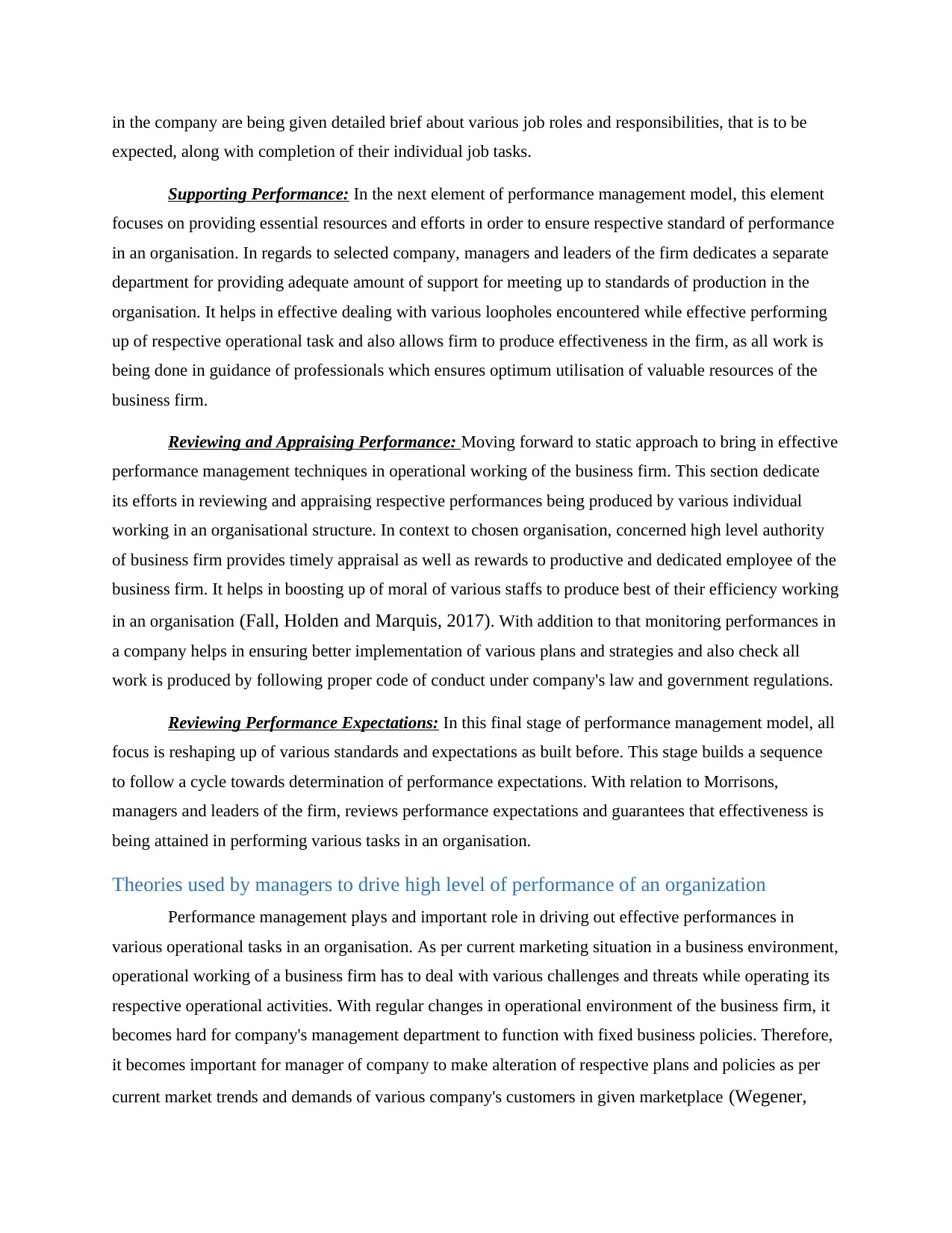
in the company are being given detailed brief about various job roles and responsibilities, that is to be
expected, along with completion of their individual job tasks.
Supporting Performance: In the next element of performance management model, this element
focuses on providing essential resources and efforts in order to ensure respective standard of performance
in an organisation. In regards to selected company, managers and leaders of the firm dedicates a separate
department for providing adequate amount of support for meeting up to standards of production in the
organisation. It helps in effective dealing with various loopholes encountered while effective performing
up of respective operational task and also allows firm to produce effectiveness in the firm, as all work is
being done in guidance of professionals which ensures optimum utilisation of valuable resources of the
business firm.
Reviewing and Appraising Performance: Moving forward to static approach to bring in effective
performance management techniques in operational working of the business firm. This section dedicate
its efforts in reviewing and appraising respective performances being produced by various individual
working in an organisational structure. In context to chosen organisation, concerned high level authority
of business firm provides timely appraisal as well as rewards to productive and dedicated employee of the
business firm. It helps in boosting up of moral of various staffs to produce best of their efficiency working
in an organisation (Fall, Holden and Marquis, 2017). With addition to that monitoring performances in
a company helps in ensuring better implementation of various plans and strategies and also check all
work is produced by following proper code of conduct under company's law and government regulations.
Reviewing Performance Expectations: In this final stage of performance management model, all
focus is reshaping up of various standards and expectations as built before. This stage builds a sequence
to follow a cycle towards determination of performance expectations. With relation to Morrisons,
managers and leaders of the firm, reviews performance expectations and guarantees that effectiveness is
being attained in performing various tasks in an organisation.
Theories used by managers to drive high level of performance of an organization
Performance management plays and important role in driving out effective performances in
various operational tasks in an organisation. As per current marketing situation in a business environment,
operational working of a business firm has to deal with various challenges and threats while operating its
respective operational activities. With regular changes in operational environment of the business firm, it
becomes hard for company's management department to function with fixed business policies. Therefore,
it becomes important for manager of company to make alteration of respective plans and policies as per
current market trends and demands of various company's customers in given marketplace (Wegener,
expected, along with completion of their individual job tasks.
Supporting Performance: In the next element of performance management model, this element
focuses on providing essential resources and efforts in order to ensure respective standard of performance
in an organisation. In regards to selected company, managers and leaders of the firm dedicates a separate
department for providing adequate amount of support for meeting up to standards of production in the
organisation. It helps in effective dealing with various loopholes encountered while effective performing
up of respective operational task and also allows firm to produce effectiveness in the firm, as all work is
being done in guidance of professionals which ensures optimum utilisation of valuable resources of the
business firm.
Reviewing and Appraising Performance: Moving forward to static approach to bring in effective
performance management techniques in operational working of the business firm. This section dedicate
its efforts in reviewing and appraising respective performances being produced by various individual
working in an organisational structure. In context to chosen organisation, concerned high level authority
of business firm provides timely appraisal as well as rewards to productive and dedicated employee of the
business firm. It helps in boosting up of moral of various staffs to produce best of their efficiency working
in an organisation (Fall, Holden and Marquis, 2017). With addition to that monitoring performances in
a company helps in ensuring better implementation of various plans and strategies and also check all
work is produced by following proper code of conduct under company's law and government regulations.
Reviewing Performance Expectations: In this final stage of performance management model, all
focus is reshaping up of various standards and expectations as built before. This stage builds a sequence
to follow a cycle towards determination of performance expectations. With relation to Morrisons,
managers and leaders of the firm, reviews performance expectations and guarantees that effectiveness is
being attained in performing various tasks in an organisation.
Theories used by managers to drive high level of performance of an organization
Performance management plays and important role in driving out effective performances in
various operational tasks in an organisation. As per current marketing situation in a business environment,
operational working of a business firm has to deal with various challenges and threats while operating its
respective operational activities. With regular changes in operational environment of the business firm, it
becomes hard for company's management department to function with fixed business policies. Therefore,
it becomes important for manager of company to make alteration of respective plans and policies as per
current market trends and demands of various company's customers in given marketplace (Wegener,
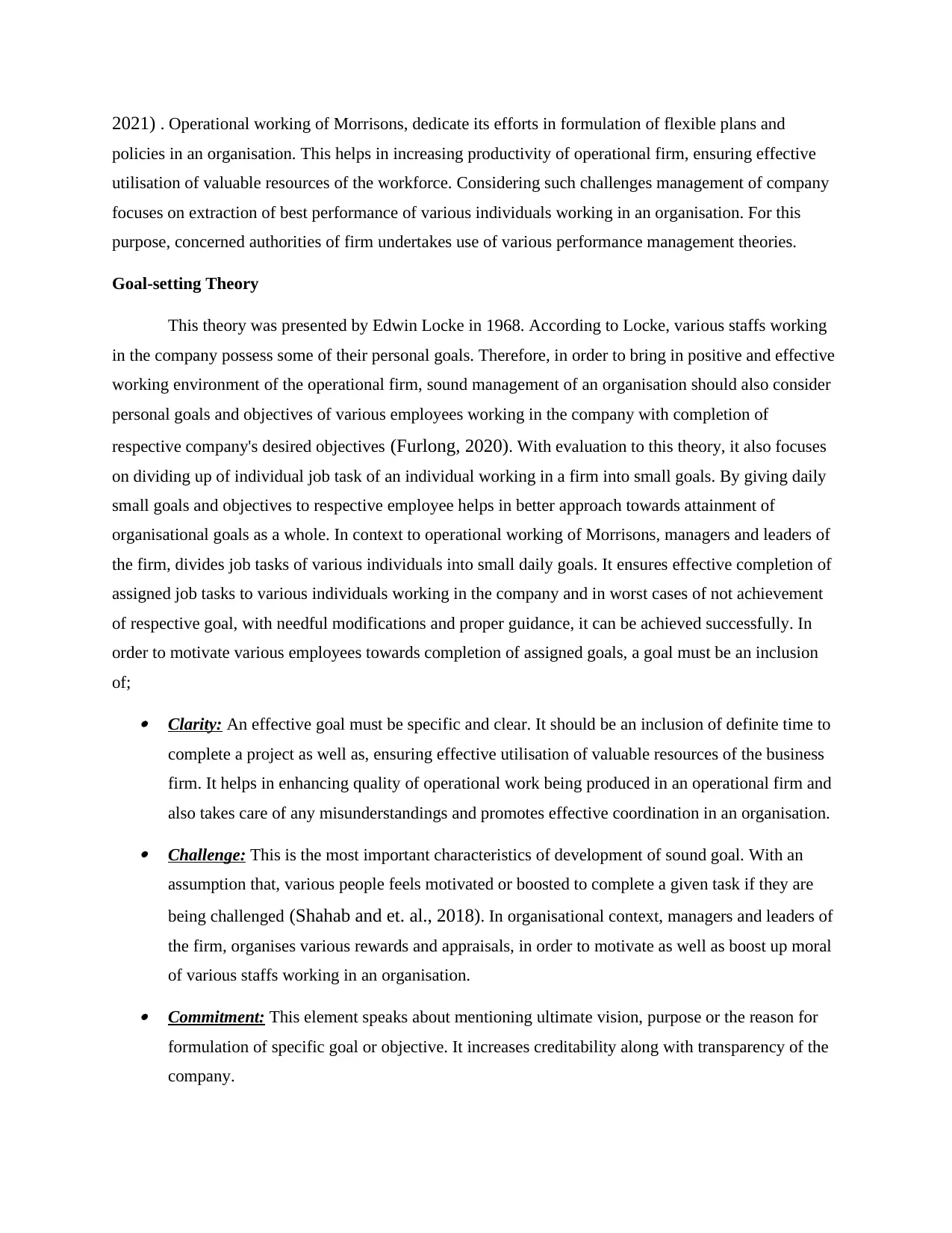
2021) . Operational working of Morrisons, dedicate its efforts in formulation of flexible plans and
policies in an organisation. This helps in increasing productivity of operational firm, ensuring effective
utilisation of valuable resources of the workforce. Considering such challenges management of company
focuses on extraction of best performance of various individuals working in an organisation. For this
purpose, concerned authorities of firm undertakes use of various performance management theories.
Goal-setting Theory
This theory was presented by Edwin Locke in 1968. According to Locke, various staffs working
in the company possess some of their personal goals. Therefore, in order to bring in positive and effective
working environment of the operational firm, sound management of an organisation should also consider
personal goals and objectives of various employees working in the company with completion of
respective company's desired objectives (Furlong, 2020). With evaluation to this theory, it also focuses
on dividing up of individual job task of an individual working in a firm into small goals. By giving daily
small goals and objectives to respective employee helps in better approach towards attainment of
organisational goals as a whole. In context to operational working of Morrisons, managers and leaders of
the firm, divides job tasks of various individuals into small daily goals. It ensures effective completion of
assigned job tasks to various individuals working in the company and in worst cases of not achievement
of respective goal, with needful modifications and proper guidance, it can be achieved successfully. In
order to motivate various employees towards completion of assigned goals, a goal must be an inclusion
of; Clarity: An effective goal must be specific and clear. It should be an inclusion of definite time to
complete a project as well as, ensuring effective utilisation of valuable resources of the business
firm. It helps in enhancing quality of operational work being produced in an operational firm and
also takes care of any misunderstandings and promotes effective coordination in an organisation. Challenge: This is the most important characteristics of development of sound goal. With an
assumption that, various people feels motivated or boosted to complete a given task if they are
being challenged (Shahab and et. al., 2018). In organisational context, managers and leaders of
the firm, organises various rewards and appraisals, in order to motivate as well as boost up moral
of various staffs working in an organisation. Commitment: This element speaks about mentioning ultimate vision, purpose or the reason for
formulation of specific goal or objective. It increases creditability along with transparency of the
company.
policies in an organisation. This helps in increasing productivity of operational firm, ensuring effective
utilisation of valuable resources of the workforce. Considering such challenges management of company
focuses on extraction of best performance of various individuals working in an organisation. For this
purpose, concerned authorities of firm undertakes use of various performance management theories.
Goal-setting Theory
This theory was presented by Edwin Locke in 1968. According to Locke, various staffs working
in the company possess some of their personal goals. Therefore, in order to bring in positive and effective
working environment of the operational firm, sound management of an organisation should also consider
personal goals and objectives of various employees working in the company with completion of
respective company's desired objectives (Furlong, 2020). With evaluation to this theory, it also focuses
on dividing up of individual job task of an individual working in a firm into small goals. By giving daily
small goals and objectives to respective employee helps in better approach towards attainment of
organisational goals as a whole. In context to operational working of Morrisons, managers and leaders of
the firm, divides job tasks of various individuals into small daily goals. It ensures effective completion of
assigned job tasks to various individuals working in the company and in worst cases of not achievement
of respective goal, with needful modifications and proper guidance, it can be achieved successfully. In
order to motivate various employees towards completion of assigned goals, a goal must be an inclusion
of; Clarity: An effective goal must be specific and clear. It should be an inclusion of definite time to
complete a project as well as, ensuring effective utilisation of valuable resources of the business
firm. It helps in enhancing quality of operational work being produced in an operational firm and
also takes care of any misunderstandings and promotes effective coordination in an organisation. Challenge: This is the most important characteristics of development of sound goal. With an
assumption that, various people feels motivated or boosted to complete a given task if they are
being challenged (Shahab and et. al., 2018). In organisational context, managers and leaders of
the firm, organises various rewards and appraisals, in order to motivate as well as boost up moral
of various staffs working in an organisation. Commitment: This element speaks about mentioning ultimate vision, purpose or the reason for
formulation of specific goal or objective. It increases creditability along with transparency of the
company.
⊘ This is a preview!⊘
Do you want full access?
Subscribe today to unlock all pages.

Trusted by 1+ million students worldwide
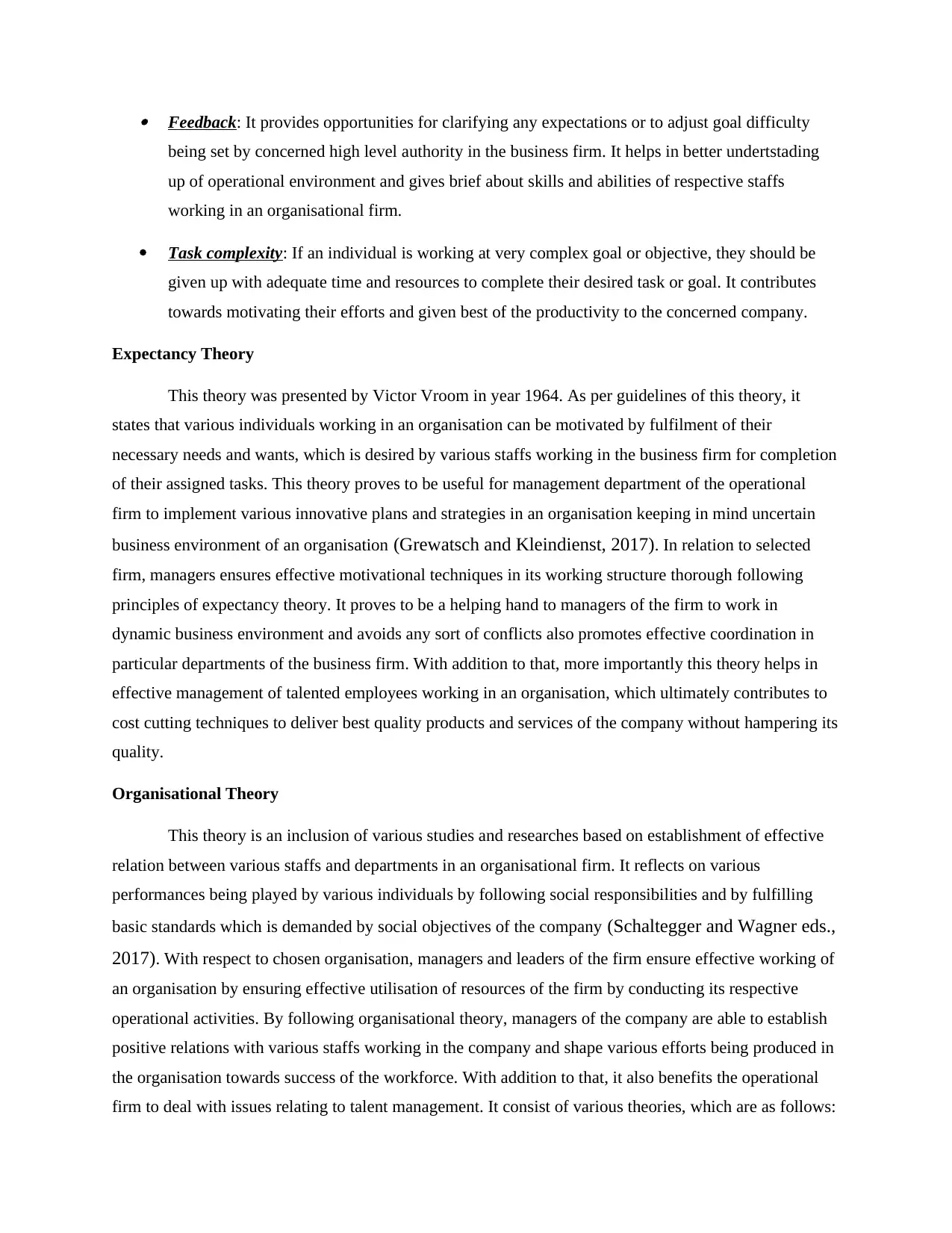
Feedback: It provides opportunities for clarifying any expectations or to adjust goal difficulty
being set by concerned high level authority in the business firm. It helps in better undertstading
up of operational environment and gives brief about skills and abilities of respective staffs
working in an organisational firm.
Task complexity: If an individual is working at very complex goal or objective, they should be
given up with adequate time and resources to complete their desired task or goal. It contributes
towards motivating their efforts and given best of the productivity to the concerned company.
Expectancy Theory
This theory was presented by Victor Vroom in year 1964. As per guidelines of this theory, it
states that various individuals working in an organisation can be motivated by fulfilment of their
necessary needs and wants, which is desired by various staffs working in the business firm for completion
of their assigned tasks. This theory proves to be useful for management department of the operational
firm to implement various innovative plans and strategies in an organisation keeping in mind uncertain
business environment of an organisation (Grewatsch and Kleindienst, 2017). In relation to selected
firm, managers ensures effective motivational techniques in its working structure thorough following
principles of expectancy theory. It proves to be a helping hand to managers of the firm to work in
dynamic business environment and avoids any sort of conflicts also promotes effective coordination in
particular departments of the business firm. With addition to that, more importantly this theory helps in
effective management of talented employees working in an organisation, which ultimately contributes to
cost cutting techniques to deliver best quality products and services of the company without hampering its
quality.
Organisational Theory
This theory is an inclusion of various studies and researches based on establishment of effective
relation between various staffs and departments in an organisational firm. It reflects on various
performances being played by various individuals by following social responsibilities and by fulfilling
basic standards which is demanded by social objectives of the company (Schaltegger and Wagner eds.,
2017). With respect to chosen organisation, managers and leaders of the firm ensure effective working of
an organisation by ensuring effective utilisation of resources of the firm by conducting its respective
operational activities. By following organisational theory, managers of the company are able to establish
positive relations with various staffs working in the company and shape various efforts being produced in
the organisation towards success of the workforce. With addition to that, it also benefits the operational
firm to deal with issues relating to talent management. It consist of various theories, which are as follows:
being set by concerned high level authority in the business firm. It helps in better undertstading
up of operational environment and gives brief about skills and abilities of respective staffs
working in an organisational firm.
Task complexity: If an individual is working at very complex goal or objective, they should be
given up with adequate time and resources to complete their desired task or goal. It contributes
towards motivating their efforts and given best of the productivity to the concerned company.
Expectancy Theory
This theory was presented by Victor Vroom in year 1964. As per guidelines of this theory, it
states that various individuals working in an organisation can be motivated by fulfilment of their
necessary needs and wants, which is desired by various staffs working in the business firm for completion
of their assigned tasks. This theory proves to be useful for management department of the operational
firm to implement various innovative plans and strategies in an organisation keeping in mind uncertain
business environment of an organisation (Grewatsch and Kleindienst, 2017). In relation to selected
firm, managers ensures effective motivational techniques in its working structure thorough following
principles of expectancy theory. It proves to be a helping hand to managers of the firm to work in
dynamic business environment and avoids any sort of conflicts also promotes effective coordination in
particular departments of the business firm. With addition to that, more importantly this theory helps in
effective management of talented employees working in an organisation, which ultimately contributes to
cost cutting techniques to deliver best quality products and services of the company without hampering its
quality.
Organisational Theory
This theory is an inclusion of various studies and researches based on establishment of effective
relation between various staffs and departments in an organisational firm. It reflects on various
performances being played by various individuals by following social responsibilities and by fulfilling
basic standards which is demanded by social objectives of the company (Schaltegger and Wagner eds.,
2017). With respect to chosen organisation, managers and leaders of the firm ensure effective working of
an organisation by ensuring effective utilisation of resources of the firm by conducting its respective
operational activities. By following organisational theory, managers of the company are able to establish
positive relations with various staffs working in the company and shape various efforts being produced in
the organisation towards success of the workforce. With addition to that, it also benefits the operational
firm to deal with issues relating to talent management. It consist of various theories, which are as follows:
Paraphrase This Document
Need a fresh take? Get an instant paraphrase of this document with our AI Paraphraser
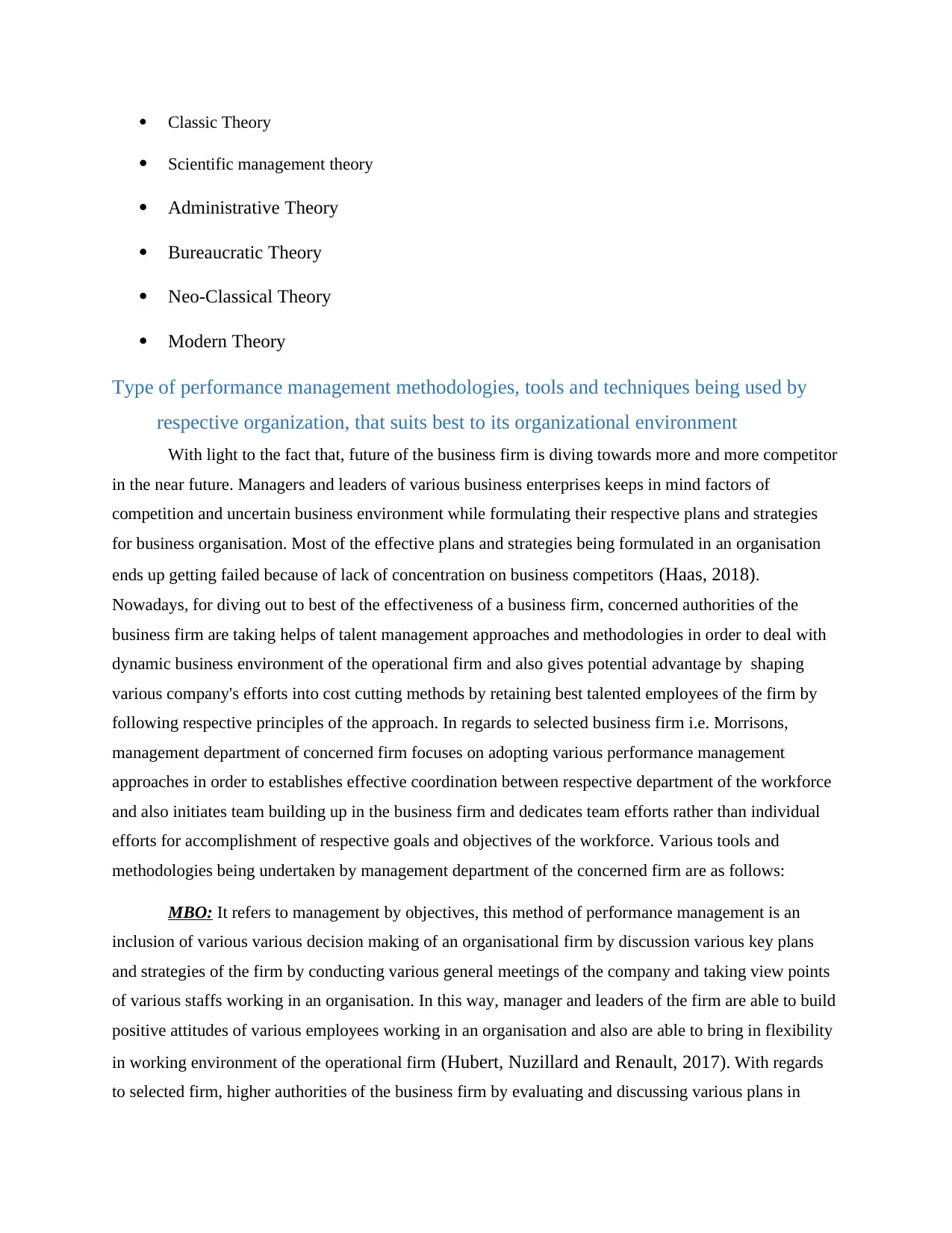
Classic Theory
Scientific management theory
Administrative Theory
Bureaucratic Theory
Neo-Classical Theory
Modern Theory
Type of performance management methodologies, tools and techniques being used by
respective organization, that suits best to its organizational environment
With light to the fact that, future of the business firm is diving towards more and more competitor
in the near future. Managers and leaders of various business enterprises keeps in mind factors of
competition and uncertain business environment while formulating their respective plans and strategies
for business organisation. Most of the effective plans and strategies being formulated in an organisation
ends up getting failed because of lack of concentration on business competitors (Haas, 2018).
Nowadays, for diving out to best of the effectiveness of a business firm, concerned authorities of the
business firm are taking helps of talent management approaches and methodologies in order to deal with
dynamic business environment of the operational firm and also gives potential advantage by shaping
various company's efforts into cost cutting methods by retaining best talented employees of the firm by
following respective principles of the approach. In regards to selected business firm i.e. Morrisons,
management department of concerned firm focuses on adopting various performance management
approaches in order to establishes effective coordination between respective department of the workforce
and also initiates team building up in the business firm and dedicates team efforts rather than individual
efforts for accomplishment of respective goals and objectives of the workforce. Various tools and
methodologies being undertaken by management department of the concerned firm are as follows:
MBO: It refers to management by objectives, this method of performance management is an
inclusion of various various decision making of an organisational firm by discussion various key plans
and strategies of the firm by conducting various general meetings of the company and taking view points
of various staffs working in an organisation. In this way, manager and leaders of the firm are able to build
positive attitudes of various employees working in an organisation and also are able to bring in flexibility
in working environment of the operational firm (Hubert, Nuzillard and Renault, 2017). With regards
to selected firm, higher authorities of the business firm by evaluating and discussing various plans in
Scientific management theory
Administrative Theory
Bureaucratic Theory
Neo-Classical Theory
Modern Theory
Type of performance management methodologies, tools and techniques being used by
respective organization, that suits best to its organizational environment
With light to the fact that, future of the business firm is diving towards more and more competitor
in the near future. Managers and leaders of various business enterprises keeps in mind factors of
competition and uncertain business environment while formulating their respective plans and strategies
for business organisation. Most of the effective plans and strategies being formulated in an organisation
ends up getting failed because of lack of concentration on business competitors (Haas, 2018).
Nowadays, for diving out to best of the effectiveness of a business firm, concerned authorities of the
business firm are taking helps of talent management approaches and methodologies in order to deal with
dynamic business environment of the operational firm and also gives potential advantage by shaping
various company's efforts into cost cutting methods by retaining best talented employees of the firm by
following respective principles of the approach. In regards to selected business firm i.e. Morrisons,
management department of concerned firm focuses on adopting various performance management
approaches in order to establishes effective coordination between respective department of the workforce
and also initiates team building up in the business firm and dedicates team efforts rather than individual
efforts for accomplishment of respective goals and objectives of the workforce. Various tools and
methodologies being undertaken by management department of the concerned firm are as follows:
MBO: It refers to management by objectives, this method of performance management is an
inclusion of various various decision making of an organisational firm by discussion various key plans
and strategies of the firm by conducting various general meetings of the company and taking view points
of various staffs working in an organisation. In this way, manager and leaders of the firm are able to build
positive attitudes of various employees working in an organisation and also are able to bring in flexibility
in working environment of the operational firm (Hubert, Nuzillard and Renault, 2017). With regards
to selected firm, higher authorities of the business firm by evaluating and discussing various plans in
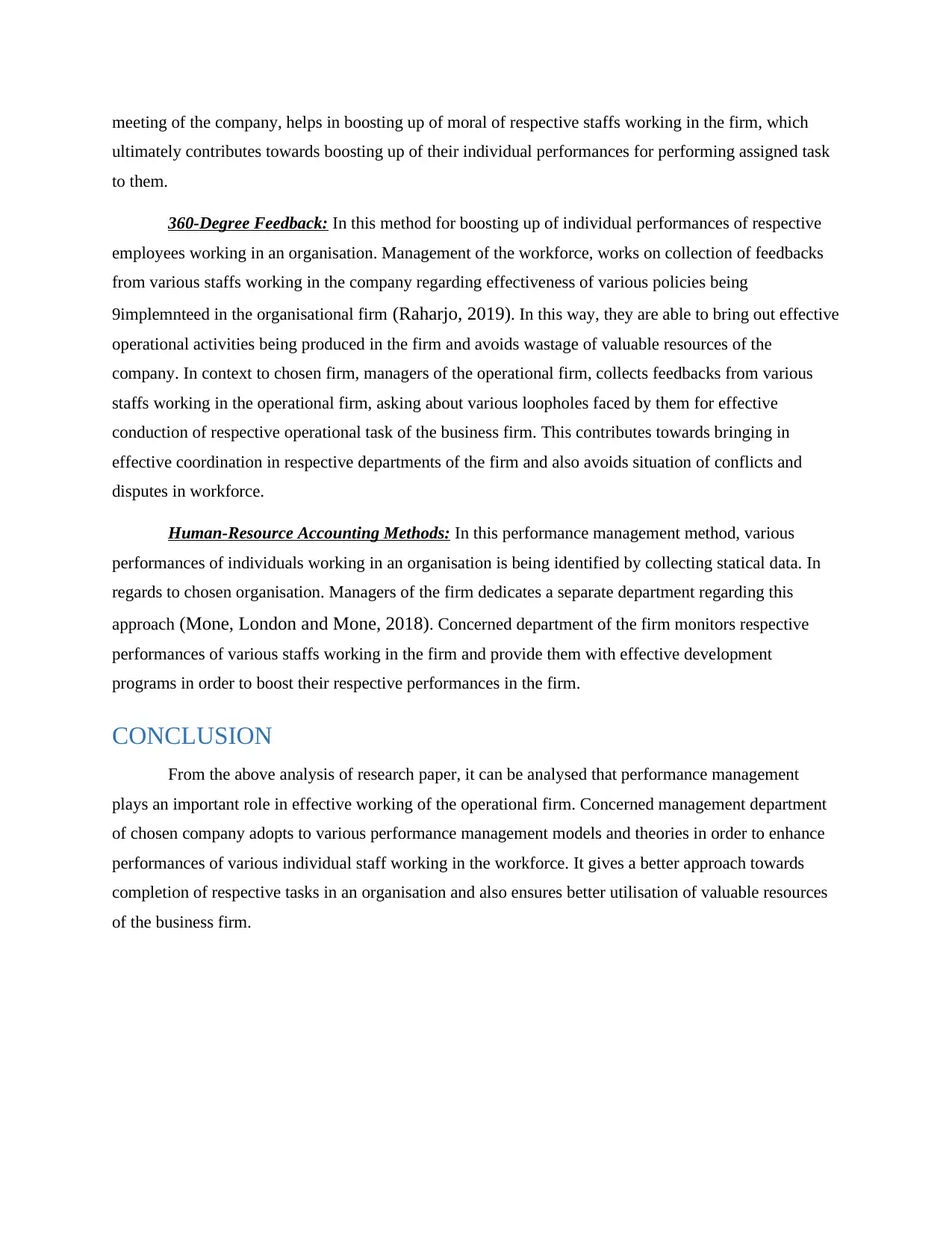
meeting of the company, helps in boosting up of moral of respective staffs working in the firm, which
ultimately contributes towards boosting up of their individual performances for performing assigned task
to them.
360-Degree Feedback: In this method for boosting up of individual performances of respective
employees working in an organisation. Management of the workforce, works on collection of feedbacks
from various staffs working in the company regarding effectiveness of various policies being
9implemnteed in the organisational firm (Raharjo, 2019). In this way, they are able to bring out effective
operational activities being produced in the firm and avoids wastage of valuable resources of the
company. In context to chosen firm, managers of the operational firm, collects feedbacks from various
staffs working in the operational firm, asking about various loopholes faced by them for effective
conduction of respective operational task of the business firm. This contributes towards bringing in
effective coordination in respective departments of the firm and also avoids situation of conflicts and
disputes in workforce.
Human-Resource Accounting Methods: In this performance management method, various
performances of individuals working in an organisation is being identified by collecting statical data. In
regards to chosen organisation. Managers of the firm dedicates a separate department regarding this
approach (Mone, London and Mone, 2018). Concerned department of the firm monitors respective
performances of various staffs working in the firm and provide them with effective development
programs in order to boost their respective performances in the firm.
CONCLUSION
From the above analysis of research paper, it can be analysed that performance management
plays an important role in effective working of the operational firm. Concerned management department
of chosen company adopts to various performance management models and theories in order to enhance
performances of various individual staff working in the workforce. It gives a better approach towards
completion of respective tasks in an organisation and also ensures better utilisation of valuable resources
of the business firm.
ultimately contributes towards boosting up of their individual performances for performing assigned task
to them.
360-Degree Feedback: In this method for boosting up of individual performances of respective
employees working in an organisation. Management of the workforce, works on collection of feedbacks
from various staffs working in the company regarding effectiveness of various policies being
9implemnteed in the organisational firm (Raharjo, 2019). In this way, they are able to bring out effective
operational activities being produced in the firm and avoids wastage of valuable resources of the
company. In context to chosen firm, managers of the operational firm, collects feedbacks from various
staffs working in the operational firm, asking about various loopholes faced by them for effective
conduction of respective operational task of the business firm. This contributes towards bringing in
effective coordination in respective departments of the firm and also avoids situation of conflicts and
disputes in workforce.
Human-Resource Accounting Methods: In this performance management method, various
performances of individuals working in an organisation is being identified by collecting statical data. In
regards to chosen organisation. Managers of the firm dedicates a separate department regarding this
approach (Mone, London and Mone, 2018). Concerned department of the firm monitors respective
performances of various staffs working in the firm and provide them with effective development
programs in order to boost their respective performances in the firm.
CONCLUSION
From the above analysis of research paper, it can be analysed that performance management
plays an important role in effective working of the operational firm. Concerned management department
of chosen company adopts to various performance management models and theories in order to enhance
performances of various individual staff working in the workforce. It gives a better approach towards
completion of respective tasks in an organisation and also ensures better utilisation of valuable resources
of the business firm.
⊘ This is a preview!⊘
Do you want full access?
Subscribe today to unlock all pages.

Trusted by 1+ million students worldwide
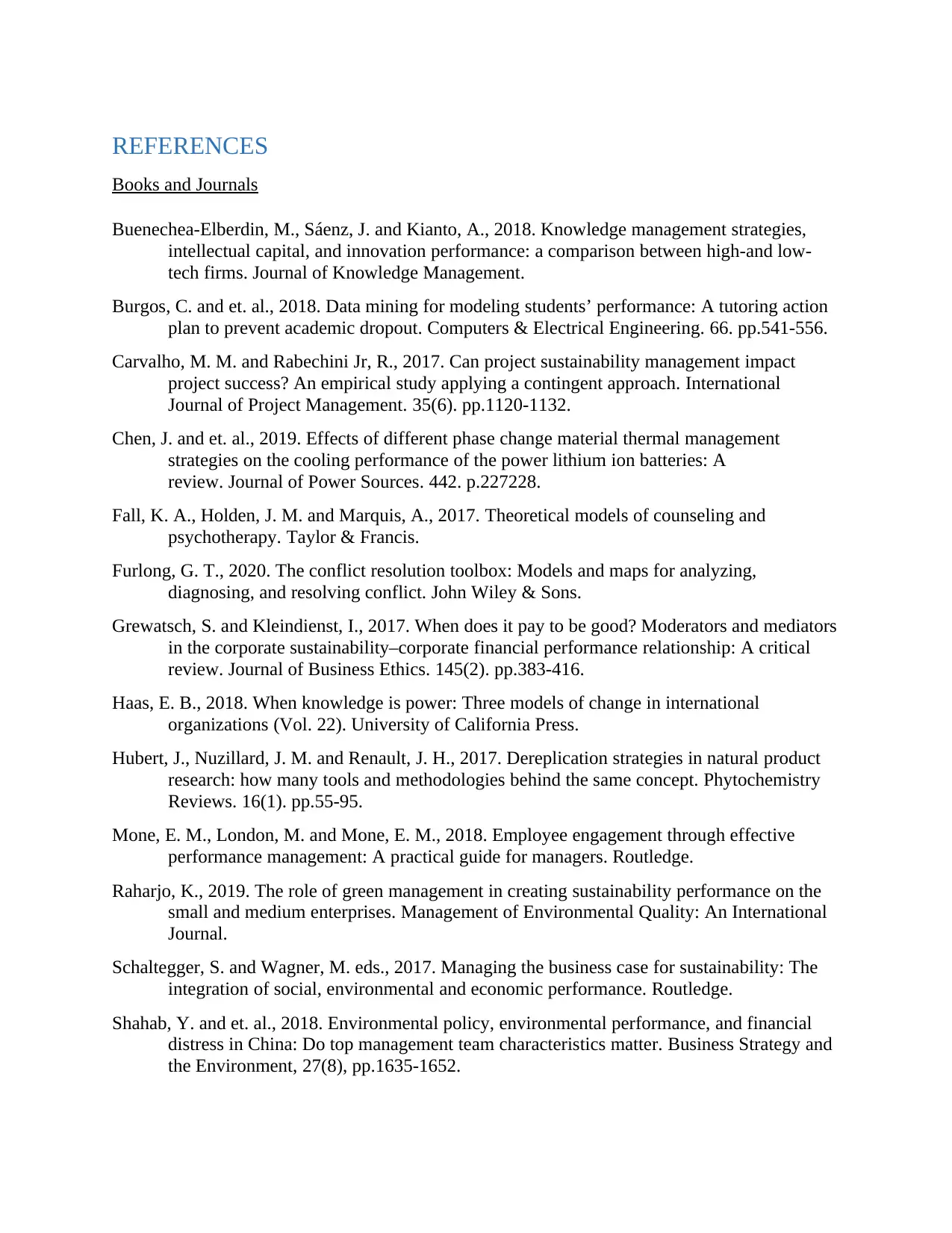
REFERENCES
Books and Journals
Buenechea-Elberdin, M., Sáenz, J. and Kianto, A., 2018. Knowledge management strategies,
intellectual capital, and innovation performance: a comparison between high-and low-
tech firms. Journal of Knowledge Management.
Burgos, C. and et. al., 2018. Data mining for modeling students’ performance: A tutoring action
plan to prevent academic dropout. Computers & Electrical Engineering. 66. pp.541-556.
Carvalho, M. M. and Rabechini Jr, R., 2017. Can project sustainability management impact
project success? An empirical study applying a contingent approach. International
Journal of Project Management. 35(6). pp.1120-1132.
Chen, J. and et. al., 2019. Effects of different phase change material thermal management
strategies on the cooling performance of the power lithium ion batteries: A
review. Journal of Power Sources. 442. p.227228.
Fall, K. A., Holden, J. M. and Marquis, A., 2017. Theoretical models of counseling and
psychotherapy. Taylor & Francis.
Furlong, G. T., 2020. The conflict resolution toolbox: Models and maps for analyzing,
diagnosing, and resolving conflict. John Wiley & Sons.
Grewatsch, S. and Kleindienst, I., 2017. When does it pay to be good? Moderators and mediators
in the corporate sustainability–corporate financial performance relationship: A critical
review. Journal of Business Ethics. 145(2). pp.383-416.
Haas, E. B., 2018. When knowledge is power: Three models of change in international
organizations (Vol. 22). University of California Press.
Hubert, J., Nuzillard, J. M. and Renault, J. H., 2017. Dereplication strategies in natural product
research: how many tools and methodologies behind the same concept. Phytochemistry
Reviews. 16(1). pp.55-95.
Mone, E. M., London, M. and Mone, E. M., 2018. Employee engagement through effective
performance management: A practical guide for managers. Routledge.
Raharjo, K., 2019. The role of green management in creating sustainability performance on the
small and medium enterprises. Management of Environmental Quality: An International
Journal.
Schaltegger, S. and Wagner, M. eds., 2017. Managing the business case for sustainability: The
integration of social, environmental and economic performance. Routledge.
Shahab, Y. and et. al., 2018. Environmental policy, environmental performance, and financial
distress in China: Do top management team characteristics matter. Business Strategy and
the Environment, 27(8), pp.1635-1652.
Books and Journals
Buenechea-Elberdin, M., Sáenz, J. and Kianto, A., 2018. Knowledge management strategies,
intellectual capital, and innovation performance: a comparison between high-and low-
tech firms. Journal of Knowledge Management.
Burgos, C. and et. al., 2018. Data mining for modeling students’ performance: A tutoring action
plan to prevent academic dropout. Computers & Electrical Engineering. 66. pp.541-556.
Carvalho, M. M. and Rabechini Jr, R., 2017. Can project sustainability management impact
project success? An empirical study applying a contingent approach. International
Journal of Project Management. 35(6). pp.1120-1132.
Chen, J. and et. al., 2019. Effects of different phase change material thermal management
strategies on the cooling performance of the power lithium ion batteries: A
review. Journal of Power Sources. 442. p.227228.
Fall, K. A., Holden, J. M. and Marquis, A., 2017. Theoretical models of counseling and
psychotherapy. Taylor & Francis.
Furlong, G. T., 2020. The conflict resolution toolbox: Models and maps for analyzing,
diagnosing, and resolving conflict. John Wiley & Sons.
Grewatsch, S. and Kleindienst, I., 2017. When does it pay to be good? Moderators and mediators
in the corporate sustainability–corporate financial performance relationship: A critical
review. Journal of Business Ethics. 145(2). pp.383-416.
Haas, E. B., 2018. When knowledge is power: Three models of change in international
organizations (Vol. 22). University of California Press.
Hubert, J., Nuzillard, J. M. and Renault, J. H., 2017. Dereplication strategies in natural product
research: how many tools and methodologies behind the same concept. Phytochemistry
Reviews. 16(1). pp.55-95.
Mone, E. M., London, M. and Mone, E. M., 2018. Employee engagement through effective
performance management: A practical guide for managers. Routledge.
Raharjo, K., 2019. The role of green management in creating sustainability performance on the
small and medium enterprises. Management of Environmental Quality: An International
Journal.
Schaltegger, S. and Wagner, M. eds., 2017. Managing the business case for sustainability: The
integration of social, environmental and economic performance. Routledge.
Shahab, Y. and et. al., 2018. Environmental policy, environmental performance, and financial
distress in China: Do top management team characteristics matter. Business Strategy and
the Environment, 27(8), pp.1635-1652.
Paraphrase This Document
Need a fresh take? Get an instant paraphrase of this document with our AI Paraphraser

Wegener, M., 2021. Land-use transport interaction models. Handbook of regional science,
pp.229-246.
pp.229-246.
1 out of 11
Related Documents
Your All-in-One AI-Powered Toolkit for Academic Success.
+13062052269
info@desklib.com
Available 24*7 on WhatsApp / Email
![[object Object]](/_next/static/media/star-bottom.7253800d.svg)
Unlock your academic potential
Copyright © 2020–2025 A2Z Services. All Rights Reserved. Developed and managed by ZUCOL.





